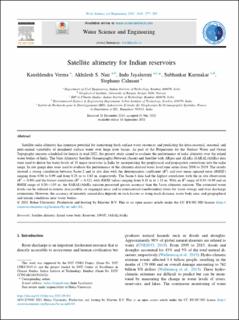Satellite altimetry for Indian reservoirs
Journal article, Peer reviewed
Published version

Åpne
Permanent lenke
https://hdl.handle.net/11250/2994210Utgivelsesdato
2021Metadata
Vis full innførselSamlinger
- Geophysical Institute [1187]
- Registrations from Cristin [9489]
Sammendrag
Satellite radar altimetry has immense potential for monitoring fresh surface water resources and predicting the intra-seasonal, seasonal, and inter-annual variability of inundated surface water over large river basins. As part of the Preparation for the Surface Water and Ocean Topography mission scheduled for launch in mid-2022, the present study aimed to evaluate the performance of radar altimetry over the inland water bodies of India. The Joint Altimetry Satellite Oceanography Network (Jason) and Satellite with ARgos and ALtiKa (SARAL/AltiKa) data were used to derive the water levels of 18 major reservoirs in India by incorporating the geophysical and propagation corrections into the radar range. In situ gauge data were used to evaluate the performance of the altimetry-derived water level time series from 2008 to 2019. The results showed a strong correlation between Jason-2 and in situ data with the determination coefficient (R2) and root mean squared error (RMSE) ranging from 0.96 to 0.99 and from 0.28 m to 1.62 m, respectively. The Jason-3 data had the highest correlation with the in situ observation (R2 = 0.99) and the lowest correlation (R2 = 0.82), with RMSE values ranging from 0.11 m to 1.18 m. With an R2 range of 0.93–0.99 and an RMSE range of 0.20–1.05 m, the SARAL/AltiKa mission presented greater accuracy than the Jason altimetry mission. The estimated water levels can be utilized in remote, inaccessible, or ungauged areas and in international transboundary rivers for water storage and river discharge estimations. However, the accuracy of remotely sensed data depends on such factors as along-track distance, water body area, and geographical and terrain conditions near water bodies.
